You Don't Know Who You Are
Until You Know From Where You Came
I have given much thought to that statement over the years; especially, as I have grown older. It also dovetails very nicely with an old New England adage: "You can take the man out of New England, but you can't take New England out of the man." So, as I thought how I would address the topic "About Me", it became evident that to know about me you have to know about the milieu into which I was born that shaped my formative years; that is, the small New England town called Greenfield, Massachusetts. That is becasue what constituted who I was when I was 18 and went off to college was formed by my surroundings and experiences growing up and how they shaped the person I became.
I grew up in Greenfield, Massachusetts which is a small town that lies nestled between the Connecticut River and Berkshire Mountains of Western Massachusetts.
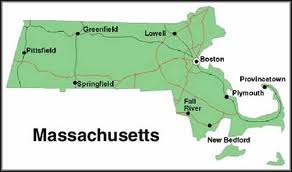
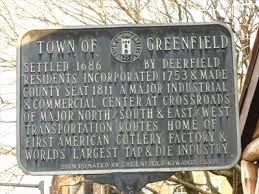
Greenfield On Massachusetts Map Greenfield Historic Marker
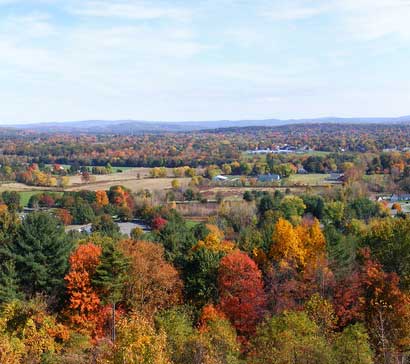
Fall Foliage In Greenfield, Massachusetts
To the left is the Historical Marker that states Greenfield was settled in 1686 by residents of Deerfield about 5 miles to the South. Greenfield has the distinction of being the only town in New England that has a Main Street that runs East and West. This is because it was hoped houses laid out from East to West would provide a warning signal to Deerfield if the Greenfield houses were attacked by Native Americans coming from the North through Vermont or from the West via the Mohawk Trail. The Marker also states Greenfield was incorporated in 1753 and became the Franklin County Seat in 1811. Prior to that, what is now Franklin County was a part of Hampshire County to the South.
The map to the right of the page shows Greenfield lies 98 miles West of Boston, 40 miles North of Springfield, 50 miles East of Pittsfield, and 20 miles South of Vermont.
The photo in the middle is taken from the beginning of the Mohawk Trail, most likely from the Long View Gift Shop formerly known as Roberts Trading Post, looking East over the Meadows and farmland toward Greenfield. On a clear day from the top of the observation tower in the 1950s, you could see into Vermont to the North and past Deerfield to the South. More importantly to the development of this part of the Pioneer Valley, you can see the meanderings of the Connecticut River, the Deerfield River, the Green River, and how they influenced the overall development of Greenfield, Bernardston about 5 miles to the North, Old Deerfield and Deerfield about 5 miles to the South, and Turners Falls about 5 miles to the East.
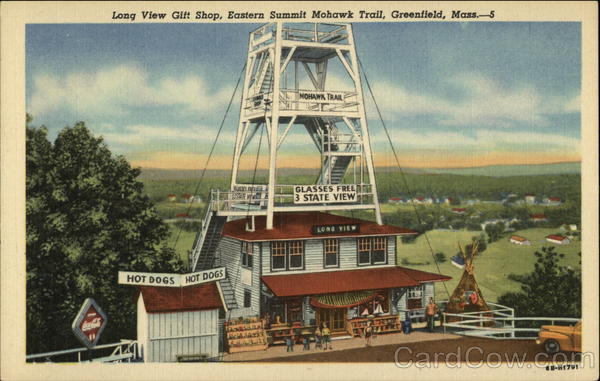
Long View Gift Shop
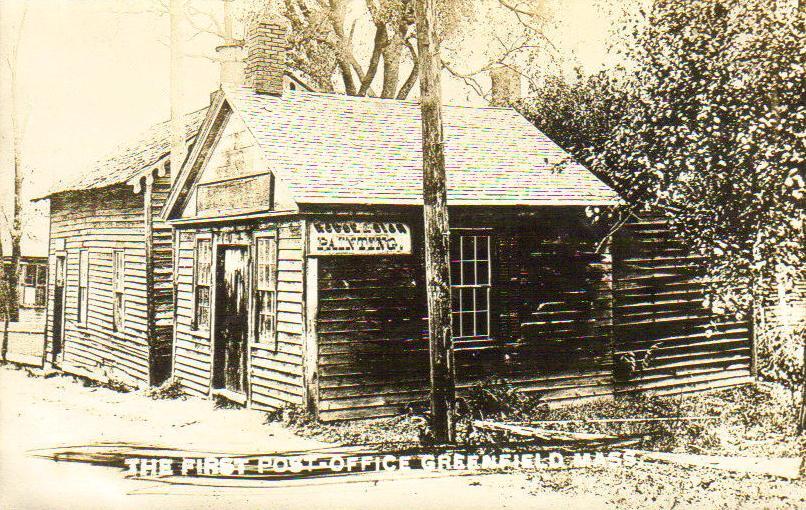
1910 Postcard Of Greenfield's First Post Office; Date Of Post Office Unknown
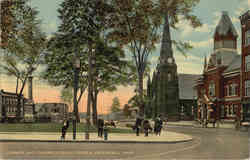
Greenfield Common Dated 1850 With The Town Hall And Second Congregational Church
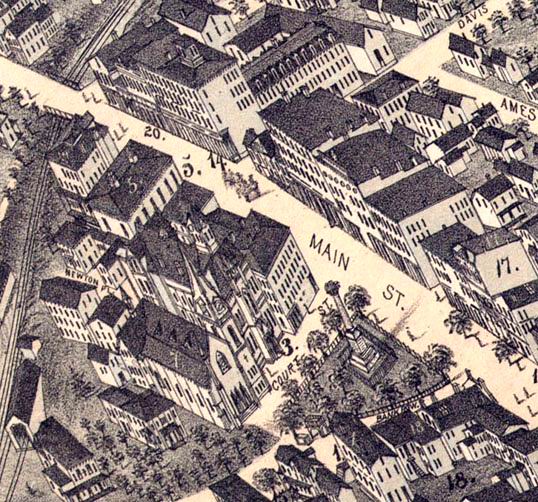
The Central Part Of Main Street Between The Common And The Railroad Tracks Dated 1870
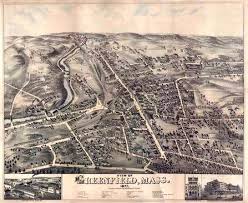
Greenfield Town Map Dated 1877
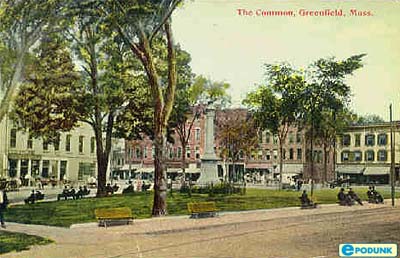
Greenfield Common Dated 1900 Looking Toward Main Street
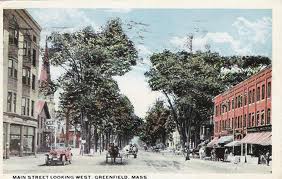
A Postcard Of Greenfield Main Street Dated 1917
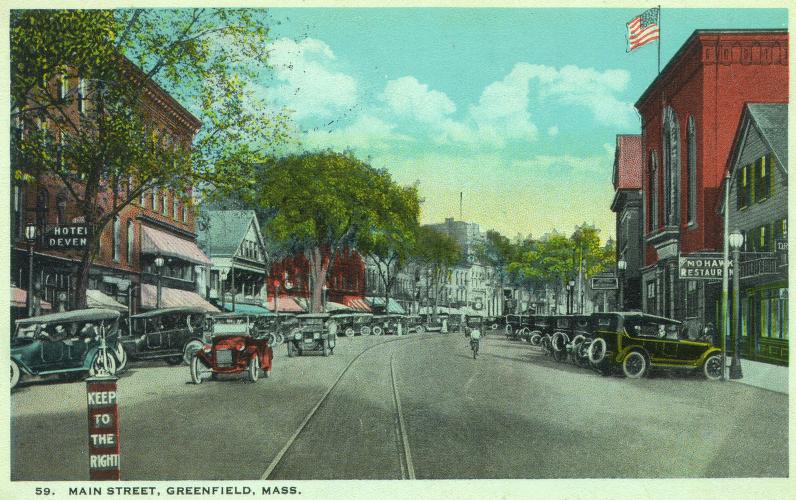
A Postcard Of Greenfield Main Street Dated 1923
Both the Mohawk Restaurant on the right and the Hotel Devon on the left were there in the 1960s
Photo Of The Mansion House Dated 1860
The Mansion House was built in 1828 on property that had formerly been a tavern built in 1720. Located at the intersection of Main Street and Federal Street, it was built at the intersection of the major highway going North and South (Routes 5&10 from New York City through Connecticut, Massachusetts, and Vermont, to the Canadian border) and East and West (Route 2 from Boston to Greenfield and then over the Mohawk Trail to Albany, Schenectady, and Troy, New York.
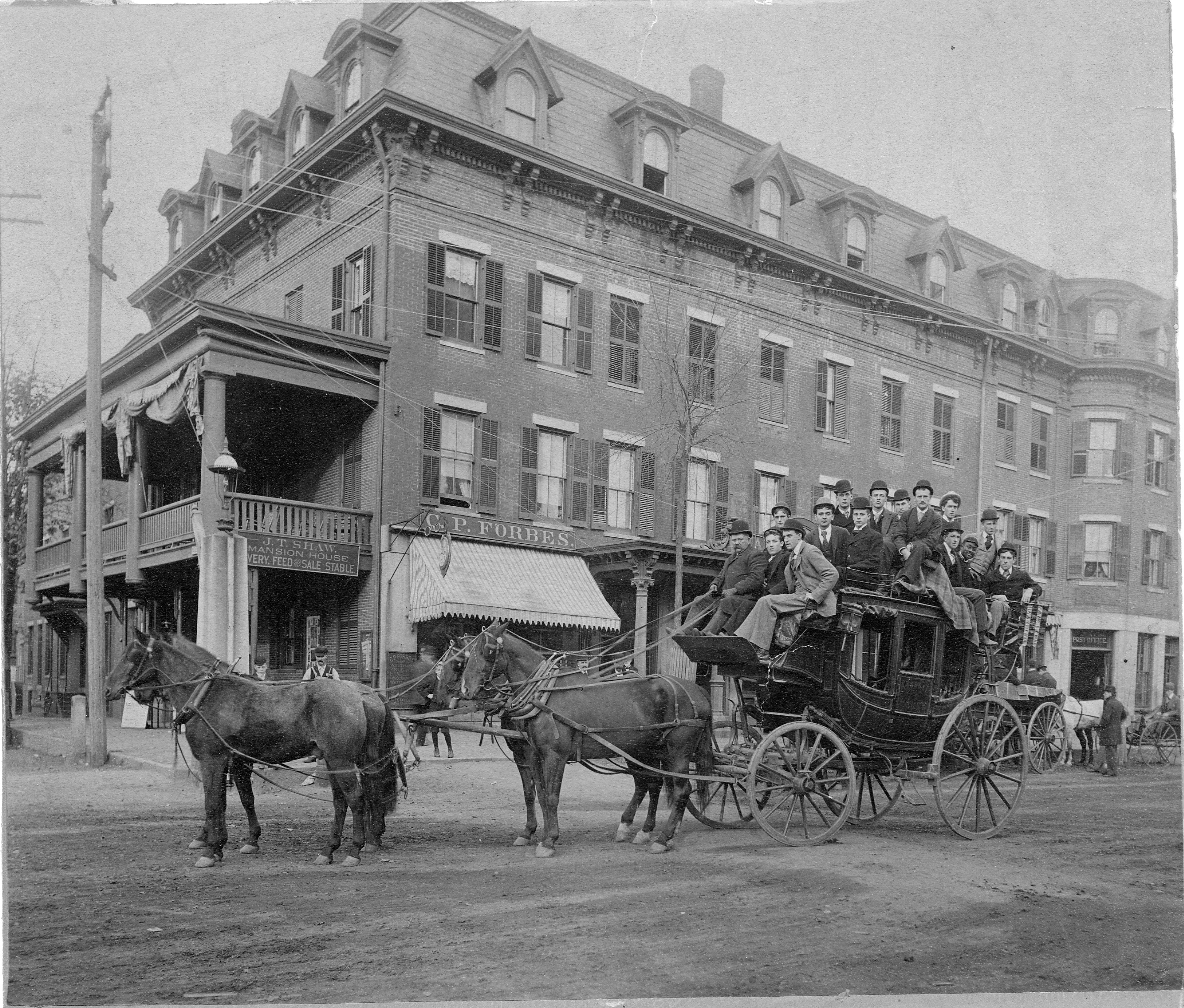
Photo Of The Mansion House Dated 1898
The young men on the stagecoach are from Amherst College, 30 miles from Greenfield, on a day's outing. The Mansion House was Greenfield's first full service, luxury hotel, and was famous for its "floating" dance floor in the Grand Ballroom. The dance floor "floated" becasue it had a system of springs under it that allowed the floor to be depressed when stood on. Thus, as dancers circled the dance floor, they seemed to float.
My grandfather, John Nicholas Sweeley, owned a barber shop in the Mansion House until he died in 1903.
The Mansion House caught on fire on one of the coldest nights of the winter of 1959. The next day, cars lined up on Main Street and Federal street to drive by, take pictures, and say goodbye to one of the town's major landmarks for 131 years. I remember seeing the huge icicles beginning at what was left of the third and fourth floors hanging down so far they touched the ground. The fire department stated it had been so cold water from the hoses froze before it got to the fourth floor.
Greenfield has two covered bridges. The first is the Green River Covered Bridge that was reconstructed in 1972 and is now closed to automobile traffic.
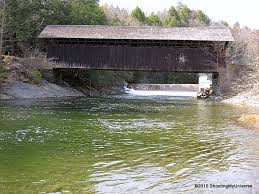
Green River Covered Bridge
The other covered bridge is the Eunice Williams Covered Bridge.
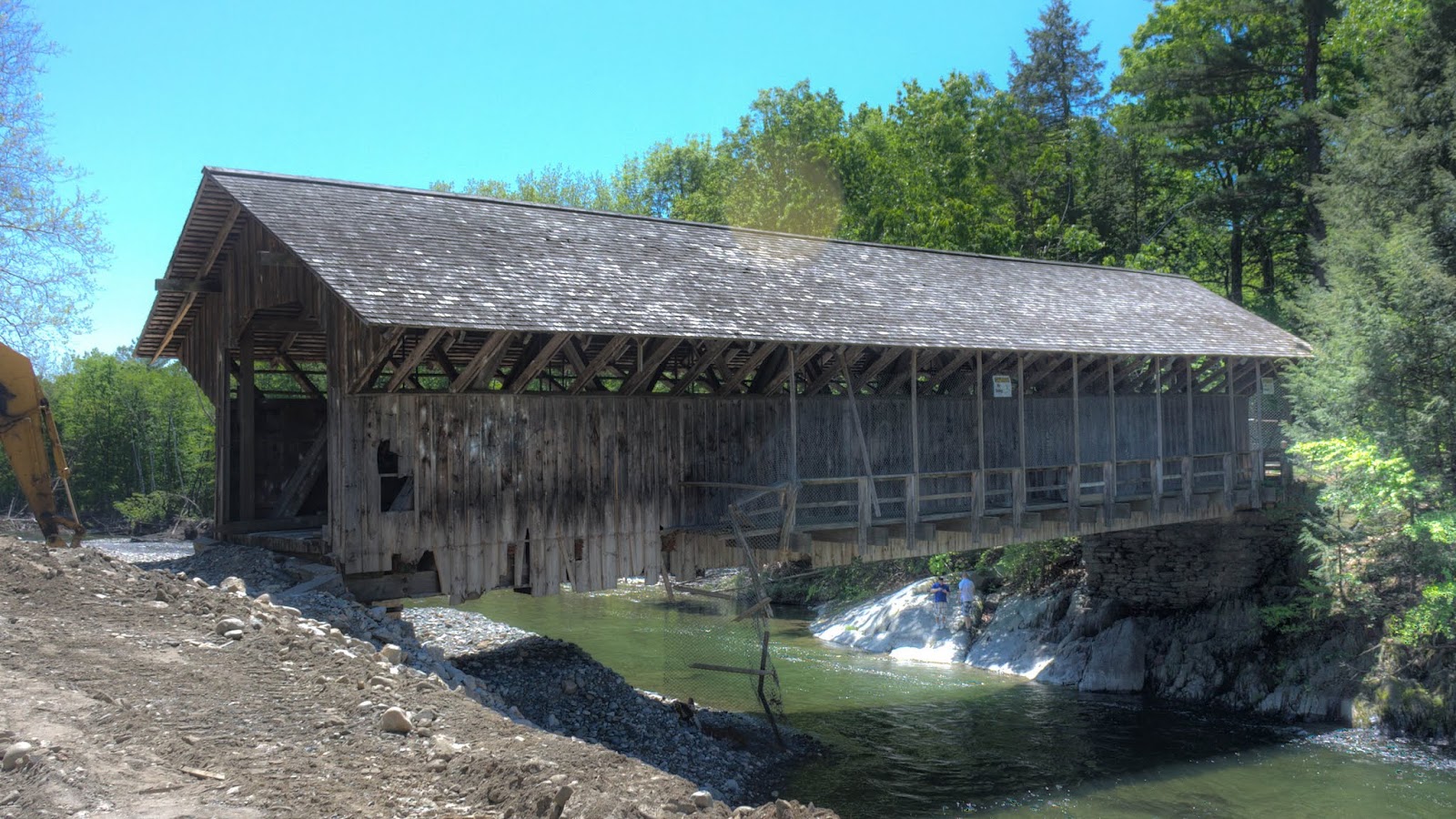
Eunice Williams Covered Bridge
Eunice Mather Williams was the wife of the Puritan minister John Williams. According to tradition, the bridge is haunted.
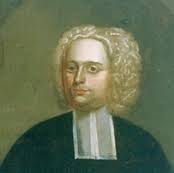
Rev. John Williams (1664-1729)
First Puritan Pastor of Deerfield, Massachusetts (1688-1704; 1707-1729)
John Williams and his wife Eunice were a part of Puritanism leading family. John Williams was the uncle of the famous preacher Jonathan Edwards. Eunice was the niece of the Rev. Increase Mather, the cousin of the Rev. Cotton Mather, and a relative of the Rev. John Cotton.
The question now becomes, "Why is the Eunice Williams Covered Bridge considered haunted?" As Paul Harvey used to say, here is the rest of the story.
On February 29, 1704, the Williams home in Deerfield, Massachusetts (known as Old Deerfield when I was growing up but later changed to Historical Deerfield with the town of Deerfield surrounding it) was attacked by 48 French soldiers including 4 of his brothers under the command of Jean-Baptiste Hertel de Rouville and their allied Abenaki, Iroquois, Wyandot, Pocumtuck, and Mohawk warriors totaling about 200 men with an additional 30-40 Pennacook joining them along the way. The day before the attack, the warriors camped on a ridge known as Mount Sugarloaf from where they could see snow drifts were piled as high as the top of the stockade fence that surrounded the village. The attack began before dawn when several warriors climbed the snow banks to go over the fence after which they opened the gate to the village allowing the attackers to freely enter.
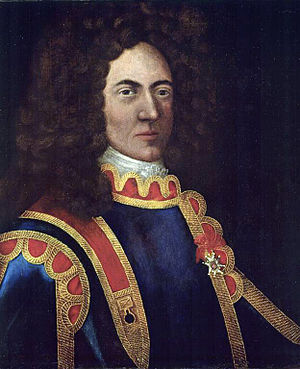
Jean-Baptiste Hertel de Rouville
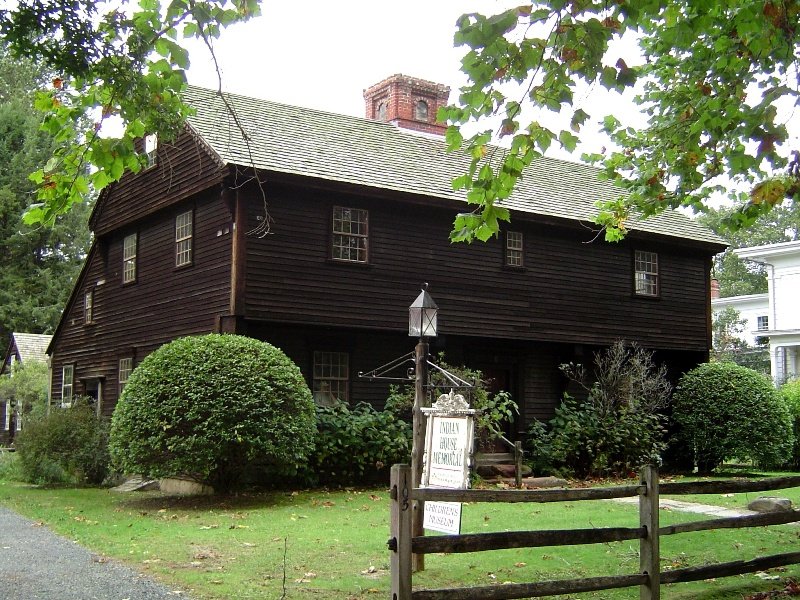
This Is A reproduction Of An Early 1700s Home Similar To The Home Of The Williams family
This attack would later be known as the Deerfield Massacre that was a part of Queen Anne's War (1702-1713). Accounts as to the number of casualties differ, but the warriors killed about 60 settlers out of approximately 200 people. Then, they took 109 captives including Rev. Williams and his wife Eunice who carried her six week old baby daughter Jerushah, their 7 year old daughter Eunice who was named after her mother, four more Williams Children including John Jr, and the Williams' slave Parthena.
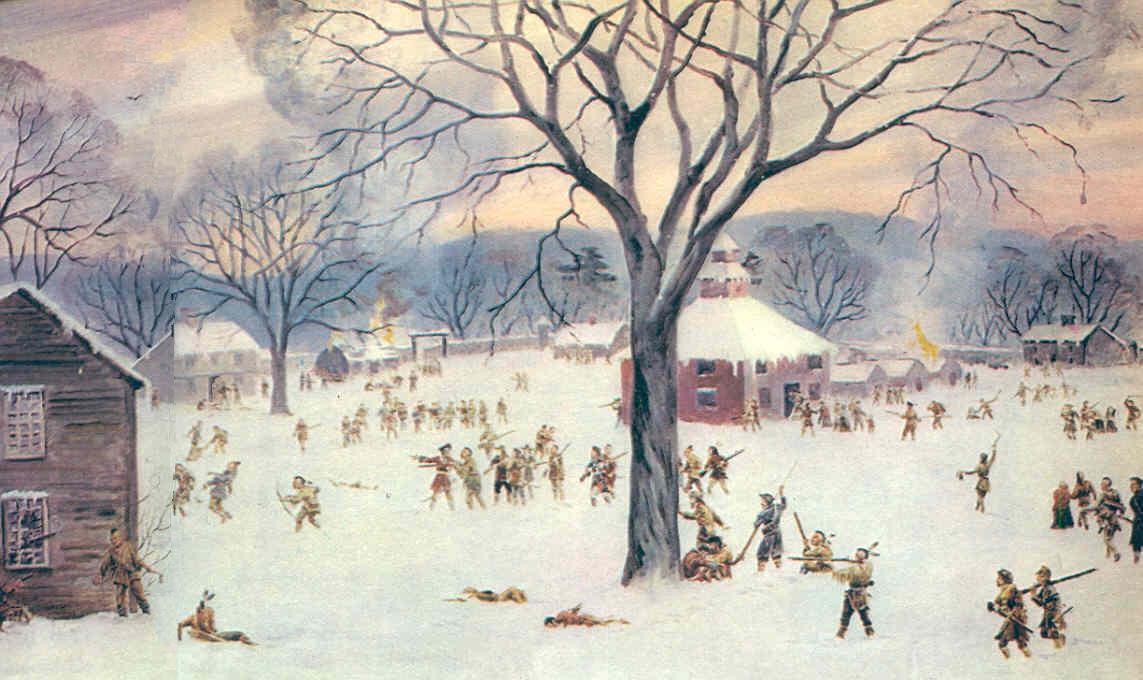
This painting Of The Attack On Old Deerfield Is The property Of The Pocumtuck Valley Memorial Association
The day after the attack, a Mohawk warrior killed Mrs. Williams and her baby when she fell crossing the Green River.
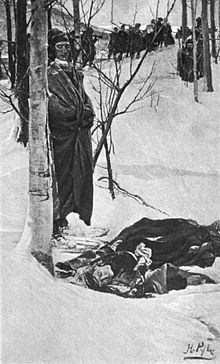
The Death of Eunice Williams
Illustration by Howard Pyle
The captives were taken on a strenuous 300 mile march to Canada. Six weeks later, they arrived in Fort Chambly in Quebec, Canada.
Shortly thereafter, the Williams family was taken to Kahnawake which was a settlement of Roman Catholic Mohawks residing South of Montreal across the St. Lawrence River.
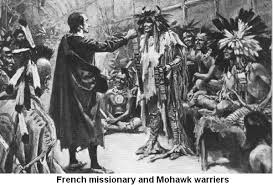
Jesuit Missionary Preaching To The Mohawks
Enice was adopted by a woman who had lost her daughter to a smallpox epidemic and was given the symbolic name, Waongote that means, "one who is planted like an Ashe". After some time, she was baptized as a Roman Catholic and given the name, Marguerite.
Eunice became fully assimilated into the Mohawk tribe and at the age of 16 married a Mohawk man named Francois-Xavier Aronsen, age 25. They had 3 children together.
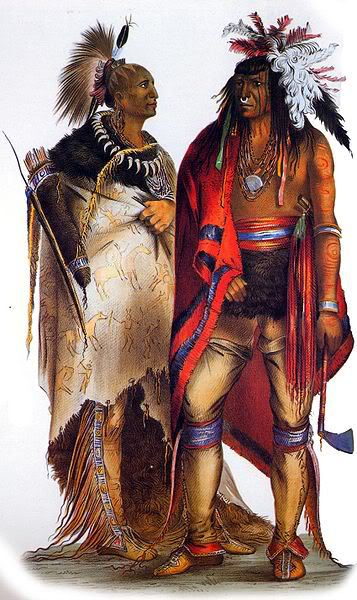
Kanenstenhawi (Eunice Williams) And Her Husband Francois-Xavier Aronsen As Portrayed In Cmiarnia, 2013
Eunice was now given the adult name Kanenstenhawi. She and her family visited Deerfield three times beginning in 1741. He father had died but her older brother John Williams, Jr. had taken his place as Deerfield's minister. However, Eunice no longer understood or spoke English but only Mohawk and French so the visits did not last long. It was reported in her brother's Diary both Eunice and her husband ate with their hands and when told they could not sleep outside on the ground, slept on the floor and not in a bed.
So, why is the Eunice Williams bridge haunted? According to legend, if you drive onto the bridge in a moonless night, shut off your headlights, and beep your horn once, the ghost of Eunice the wife of Rev. John Williams, Sr. will appear and beg for her baby Jerushah who was torn from her hands and killed as she lay bleeding to death in the river.
The Deerfield Massacre is the catalyst for three books. The first is James Fenimore Cooper's 1826, The Last of the Mohicans. Much of Cooper's source material came from Rev. John Williams' narrative titled, The Redeemed Captive written in 1707 after he returned to Deerfield. The second is Mary P. Wells Smith's 1904, The Boy Captive of Old Deerfield. When I was in elementary school, our local radio station had a children's reading hour in the late afternoon and I remember both of these books being read. The third book is John Demos' 1995, The Unredeemed Captive: A Family Story from Early America. The book tells the story of the Williams family including Eunice's life as a Mohawk until her death at the age of 95.
Greenfield in the 1940s, 50s, and early 60s, exemplified the values found in Norman Rockwell paintings of small town America that graced the covers of many Saturday Evening Post magazines.
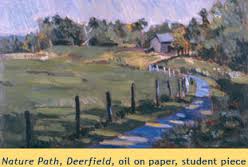
This Is A student Piece By Norman Rockwell Of A Nature Path In Deerfield, Massachusetts
He would later have a studio near this spot
One of the events that illustrates these small town values is the Thanksgiving Parade that traditionally is held on the Saturday before Thanksgiving. In the Fall of 1957, I was a freshman in high school and we had to choose which "club" we wanted to join. Each teacher had to sponsor a club and all club meetings were the last period of the day on Friday. To be honest, I was not interested in most of the clubs offered but the Thespian Club sounded good becasue I thought it would be fun to learn how to be an actor. Much to my surprise, I discovered at the first meeting I was the only male who had signed up for the Thespian Club and I joked I was the thorn among the roses.
In the middle of October, I was told by the club's sponsoring teacher that an invitation had been received from the organizers of the Thanksgiving Parade to have a freshman recite Abraham Lincoln's Gettysburg Address at the Common as a part of the celebration of the day and she wanted me to do it. So, after I had memorized the Address, we would go to the auditorium where I would get on the stage and recite the Address for her to critique.
This was the first time I spoke at a public function, especially reciting something I had memorized, but my experience in doing so in DeMolay gave me the confidence I could do it. The temperature the Saturday morning of the Thanksgiving Parade was in the low 40s. In other words, it was a typically beautiful Fall day much like the one captured in the photo below.
After the introduction of dignitaries, it was my turn to recite the Gettysburg Address and much to the delight--and I am sure relief of my parents and family--I did so without making a mistake.
However, my recitation of the Gettysburg Address held special meaning for my family becasue one of my ancestors, William Partenheimer, is cited in, The Conservative Rebel: A Social History of Greenfield, Massachusetts, as the first German-born resident to enlist in the Massachusetts 34th Light Infantry in 1862. William would later be killed in the 1864 Battle of Monocacy where the Massachusetts 34th held off General Lee's advance force near Frederick Maryland for three days until reinforcements arrived as the Confederates were on their way to sack Washington D.C.
It is becasue of the heroic stand of the Massachusetts 34th Light Infantry that General Lee was prevented from sacking Washington, D.C. Then, on April 9, 1865, the Massachusetts 34th Light Infantry had the honor of being present at the surrender of General Lee at Appomattox Court house.
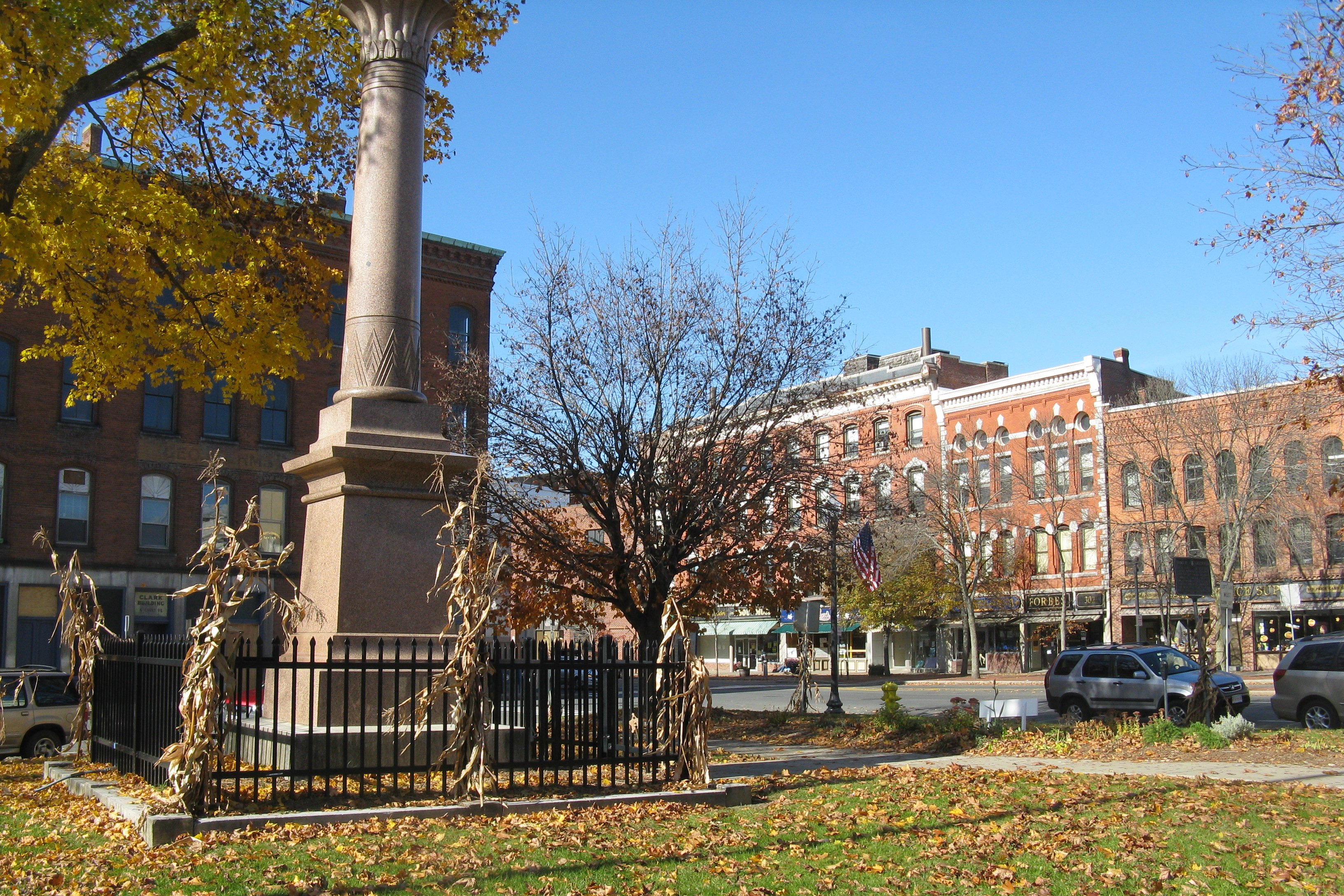
Greenfield Common today
This contemporary photo of the Greenfield Common is looking toward Main Street with the War Memorial in the foreground. Greenfield is the County Seat of Franklin County and the Main Street Historic District includes the Town Hall, County Courthouse, and several 19th century bank buildings. It also includes the Common and three properties listed on the National Registry of Historic Places. The Main Street Historic District was listed on the National Registry of Historic Places in 1988.

Poet's Seat Tower
Another famous landmark and icon of Greenfield is Poet's Seat Tower. Poet's Seat Tower is a sandstone tower built in 1912 overlooking the Town of Greenfield. It is named in honor of the long tradition of poets being drawn to the spot on the top of a cliff overlooking the town. The tower is referred to as "Poet's Seat" becasue poet Frederick Goddard Tuckerman in his herbarium entry for November 10, 1850, named it as such.
The current Poet Seat's Tower replaces an earlier wooden tower on the same spot opened to the public on June 3, 1899. This tower was built, along with a drinking fountain and a road to access the site by horseback and carriage, by the Greenfield Outdoor Club.
Many teenage boys have tried to prove their manhood by climbing the face of the cliff, including the bottom half which is hidden by the trees in this photograph, from its beginnings at the edge of Beacon Field to the summit and from there up the tower which has an iron spiraled stairway inside.
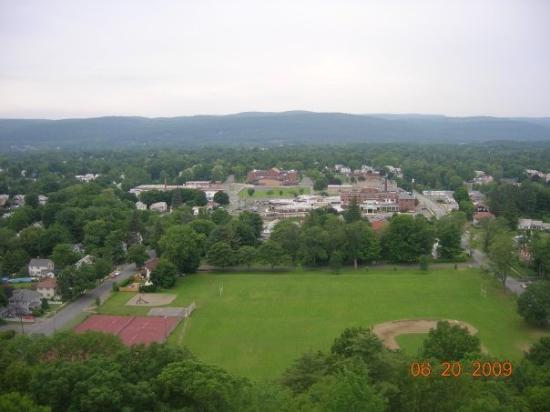
Beacon Field In Summer As Seen From Poet's Seat Tower
This 2009 view of Beacon Field is taken from the top of Poet's Seat Tower. I played tennis on the tennis courts and hit my first Pony League home run to right-center field. It was a high line drive that went over the right fielder's head and rolled across the street hidden by the trees on the far side of the field.
Beacon Field Winter Fun
We have now come full circle from the founding of the settlement of Greenfield by residents of Deerfield 328 years ago in 1686, and Greenfield's incorporation 261 years ago in 1753, to today. Over the years, Greenfield has always had a vitality and larger than its size impact on its part of Western Massachusetts becasue of its location at the juncture of the North-South and East-West means of transportation whether it was by horseback, stage coach, train, or automobile, which is why it was designated the County Seat in 1811.
As I see Greenfield today and look to the future, I am confident it will continue to be at the forefront of ushering in the years to come in Western Massachusetts by providing excellent public schools and higher education, opportunities for employment in emerging technologies and industries, and providing a cultural and social milieu that enhances the quality of life of both individuals and families.
And, I am proud to say, the torch of leadership has been passed to my generation because the Mayor of Greenfield is William F. Martin who was a childhood friend and playmate.
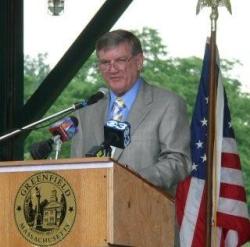
Mayor William F. Martin
Greenfield is in very capable hands with William Martin as Mayor. A few of his accomplishments include being a highly decorated combat medic during the Vietnam War where he was awarded 3 Bronze Stars with 2 Oak Leaf Clusters each for Valor as well as the Army Commendation Medal with Valor. After serving in the Army, he became a successful businessman and has given a lifetime of service to Greenfield.